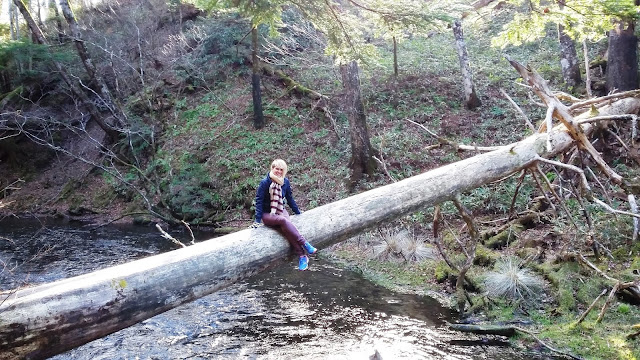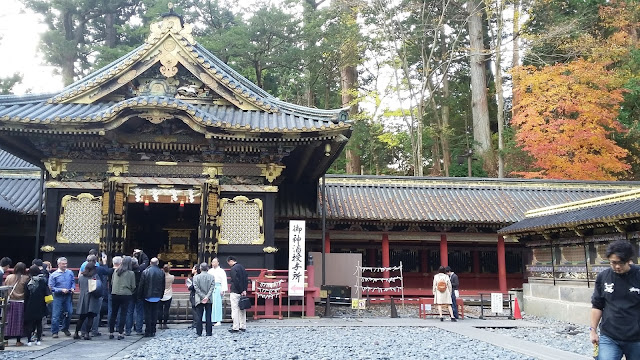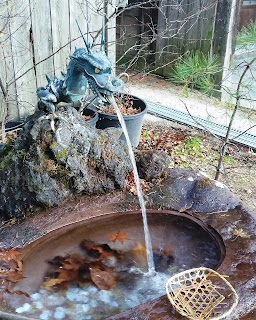Hello friends :)
Last week was off for us and so the time came to go on vacation! This means: Finally exploring other parts of Japan. Our hunt for adventures lead Essi, Alizée and me to Nikko, a small city surrounded by mountains, said to be full of beatiful autumn colours, mesmerizing landscapes and cultural treasures. So we hit an early morning train on Tuesday and went there to stay there for two nights.
Crying dragon and sleeping cat
 |
| First impression of Nikko: Small, village-like town with tourism as the only industry, where shops close very early |
 |
| Famous Shinkyo Bridge - we would have had to pay to go on it, but this was enough to see |
Our first destination was the UNESCO World Heritage Site located in the Nikko National Park, a twenty minute walk away from the train station, containing not only hundreds of years old trees, but also 103 buildings, belonging to one temple and two shrines. The largest of them all, a shrine complex called Tosho-gu, costs 1300 yen to enter but offers much to see. We could even walk inside a shrine for the first time - sadly, no photos were allowed.
On this day, it was also shishi-go-san (7-5-3) day, meaning that all children aged 3, 5 and 7 are dressed traditionally and taken to a Shinto shrine. Because these ages, being odd numbers, are considered unlucky in Japan, the visit is used to thank the local gods for past favours and pray for health and safety for the following years. It's done on November 15th since it has traditionally been a lucky day in the Japanese calendar. For us, it meant seeing a couple of cute children in kimono and hakama (traditional trousers). :)
An attraction Nikko is famous for, and which can be found on ALL merchandise products, are the three wise monkeys. I mean these:
 |
| See no evil, hear no evil, speak no evil |
 |
| Unfortunately, the most beautiful of the buildings was still under construction. This is one of the few parts you could see |
Seeking to see other shrines and temples inside the area, we found some of them closed at 4pm - the time where Japan gets dark at this time of the year (while it is as early as 5pm even in summer!). One temple which was not restricted was one in the forest next to the Shiraito falls. Bad idea it was to go into this forest in the dark. But we were very confident in Japanese security and went on, not expecting to encounter our probably most memorable adventure.
When we reached something that lookes like the temple we were looking for, an elderly Japanese man whose car was parking there asked if he could help. He said the temple we were looking for was deeper into the forest, after a set of stairs, and he used his flashlight to show us the way. When we thanked him, he even gave us the flashlight to light our way there and waited for us at the street at his car - which was strange enough. But we guessed it was just Japanese politeness. When we reached the temple, a rather spooky place in the dark - a perfect setting for a horror movie - he also suddenly came upstairs and showed us around. He then proceeded to tell us that the stairs we came up were too slippery and dangerous to come down, so he offered to show us another way to go back. We became really suspicious when he said something that sounded like "hotel", as if he wanted to lure us somewhere. So we politely refused and climbed - or rather ran - down the slippery stairs instead.
When the man came down as well, we gave him back his flashlight and thanked him for his help before moving back to the train station. It was then when we remembered the Japanese word for temple, which is otera. Sounds quite like "hotel", doesn't it?
Living like the Japanese
A highlight of our journey was certainly the accomodation. We found a Japanese woman on Airbnb offering rooms in her own for guests. Apart from the room, she offered free dinner and breakfast! That sounded like a really authentic exciting cultural experience - and it was indeed. When we arrived at the designated train station 10 minutes away from Nikko on our first evening, she was already waiting for us in her car and took us to her place. Living in a real Japanese house, we enjoyed the benefits of a Japanese bath - with a whole small extra shower room including a bathtub for a hot, relaxing bath in the evening, and a high-tech toilet which greeted you opening each time you entered (yes, always the toilet stories...). The room itself was very comfy. It has three beds and was decorated all in pink - maybe it was once a children's room? Softdrinks, tea and coffee was provided for us together with a waterboiler in the good, guest-friendly manner.
But the food! It was the best of all. Sumire-san - the woman who hosted us - took a lot of effort to make us and our bellies happy. Look at these pieces of art:
 |
| First dinner: Radish in soy sauce, miso soup, fried veggies, gyoza, cooked veggies, rice and deliciously prepared soy beans |
 |
| First breakfast: yoghurt with banana, cinnamon sugar, persimon and apples, omelette, cheese, pumpkin and cucumber salad, orange juice. Not in the picture: Toast and coffee :3 |
 |
| Second dinner: matcha salt (!), beans, a loooot of deep-fried veggies (pumpkin, mushroom, sweet potato, leeks), onigiri, radish in soy sauce |
 |
| Genmaicha (green tea with rice) after dinner |
I forgot to take a picture of the second breakfast, which contained: Blueberry tea, toast with butter and lemon curd, yoghurt with clementine, omelette, grilled mushrooms, mushroom soup, and a salad of lettuce, tomato and corn.
While we ate, Sumire-san stayed with us in the living room and talked to us, occasionally laughing and commenting on the TV program running in the background. Like this, we were able to practice our Japanese skills and watch some real Japanese game shows. Sumire-san was a very kind, patient and funny conversation partner and took the time to explain to us about the meals, Japanese words and customs. Furthermore, she brought us to the station and picked us up at any time we desired, despite her having other guests and going to work in a company en passant. It was such a pleasure to stay with her and I can highly recommend it to everyone travelling to Nikko. You can find her Airbnb offer here.
Beware the bear
 |
| A proof that we were moving in dangerous areas |
A second adventure in Nikko? Unfortunetely, neither bears nor monkeys, not even deer crossed our way while we hiked for hours on our second day. This time, we took the bus who brought us further away from Nikko: To Chuzenji Lake, one hour from the centre. (For 3000 yen, you can get a two-day Nikko bus pass which allows you to go back and forth as many times as you like, and as far as the Yumoto onsen. What that is? More on that later.)
The beatiful Kegon falls awaited us there, as well as a 3-hour hike. It takes 11km to walk around the lake; We planned on going for 6. But unfortunately, some parts of the trail are closed from October. So are the mountain trails, which destroyed our plans to climb one of the mountains around the area. Well, at least we could walk a couple of hours and see some holy places as well.
 |
| Kegon Falls |
 |
| A place where you could throw a plate for 200 yen each. Something for hidden aggressions? |
We are not alone in the woods
On our last day in Nikko, we checked one big item on our to-do list: Visiting a real Japanese onsen (hot spring). Our destination was theYumoto onsen, half an hour away from Chuzenji, a small and authentic hot spring in a forest area.
 |
| Entering Yumoto - there was noone around except for us |
The place proved to be anything else but crowded. It had several onsens and the one we visited was also a buddhist temple. As the place was rather small, we had basically a whole room for ourselves, after sharing it a while with a woman with whom we could even practice having a really basic conversation in Japanese.
Onsens are an authentic Japanese experience worth trying. It is better and even more relaxing than taking a hot bath, although it can be intimidating to be naked among strangers. Yes, in most Japanese hot springs you have to be, but fear not: Only few of them are not separated by gender. Furthermore, as soon as you enter the hot water, you forget about everything and give in to the effect of the hot, natural source water with lots of health benefits. The only bad thing about all this is the nasty sulphur smell. Here's my warning: Wash yourself and your clothes very thoroughly after taking such a bath!
We then could sit a while in a tatami room, sipping tea and eating a rice cracker after bathing.
 |
| The onsen aka temple from outside |
In order to explore the area a bit more, we went to hike the 3-hour trail back to Ryuzu Falls, where we would take our bus back to Nikko station to catch a train home in the evening.
 |
| Yutaki Falls |
On our way, we finally tried dango, traditional Japanese rice dumplings covered with a sauce.
 |
| How dango is made... reminded me of marshmallows |
 |
| This was not even sweet - but rather salty, and a very new taste |
While walking through the amazingly diverse, wild landscapes, we noticed quickly that we were not the only ones. It seemed as if all the schools in and around Nikko decided to go on hiking day, and so we met hundreds and hundreds of school children, dressed in uniforms and colourful (yellow, red or green) hats. Foreigners seem to be rather an exotic thing in that area, so they were totally excited to use all of their English skills, greeting us with "Hello!", "How are you?", "Nice to meet you!" and so on, chattering and laughing, while the teachers bowed with a polite "Konnichi wa". Just when we thought the storm was over, another large group suddenly appeared on the distant horizon. It was our hour of fame. Some of us enjoyed it, some not so much ;)
 |
| The "tree trunk challenge" was not Alizée's idea and fun to do :P |
 |
| Another one of the numerous waterfalls on our way |
 |
| A teahouse at the end of our road |
 |
| Some art next to the teahouse |
 |
| Finally: Ryuzu Falls |
These three days were a trip into the wild not only due to the prevaling nature, but also due to the opportunity to explore a less populated area, where you have to rely on your (poor) Japanese skills. It was an amazing experience and I would love to visit Nikko again somewhere in spring, to marvel at blossoming landscapes from the top of a mountain. Thank you for reading and have a fantastic weekend :)



















































"Some of us enjoyed it, some not so much", why I feel myself concerned ?
ReplyDeleteBy the way, very good article Rita ! ごくろさまです!
Haha, I have no idea ;) ありがとう! :)
Delete